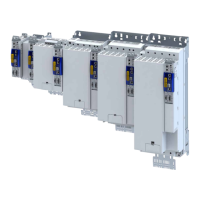7 Conguring the "Winder Dancer" TA
For the dancer control, the web tension is generated exclusively via an upstream dancer
de
vice. The advantage of a dancer device is its compensaon behaviour in the event of
dynamic disturbances, e.g. those which occur during acceleraon and imbalances in the reel.
In this case, only the dancer posion changes while the tensile force remains constant. The
dancer control is used in cases where the tensile force accuracy and tensile force consistency
must remain within a very small tolerance zone. In the case of the dancer control, the limits
are not determined by the torque seng range, but by the mechanical design of the dancer,
the dynamics (mass, fricon etc.) and the speed seng range of the drive.
Dancer-controlled systems can be used to rewind and unwind the following example materials
at speeds of up to 1000 [m/min]:
•
Cable
•
Wir
e
•
Texles
•
Films
•
Paper
The Winder Dancer technology applicaon has the following funcons:
4Con
trol sengs ^ 98
4Dening the winding direcon ^ 99
4Dening the material feeding ^
101
4Manual jog of winding sha ^ 114
4Synchronisaon to line speed ^
116
4Diameter calculaon ^ 117
4Diame
ter esmaon before dancer moon ^ 124
4Scaling the actual dancer posion ^ 127
4Dancer c
ontrol ^ 129
4Reduced controller dynamics in case of system deviaons ^ 131
4Dancer limit posion teach-in funcon ^ 132
4Acceleraon compensaon ^ 133
4
Idenfying moments of inera ^ 135
4Adapng the speed controller gain ^ 139
4Monit
oring based on the change in diameter ^ 144
4Monitoring based on the dancer posion ^ 146
4Monit
oring the dancer posion ^ 147
4Speed limitaon from the master ^ 149
Conguring the "Winder Dancer" TA
88

